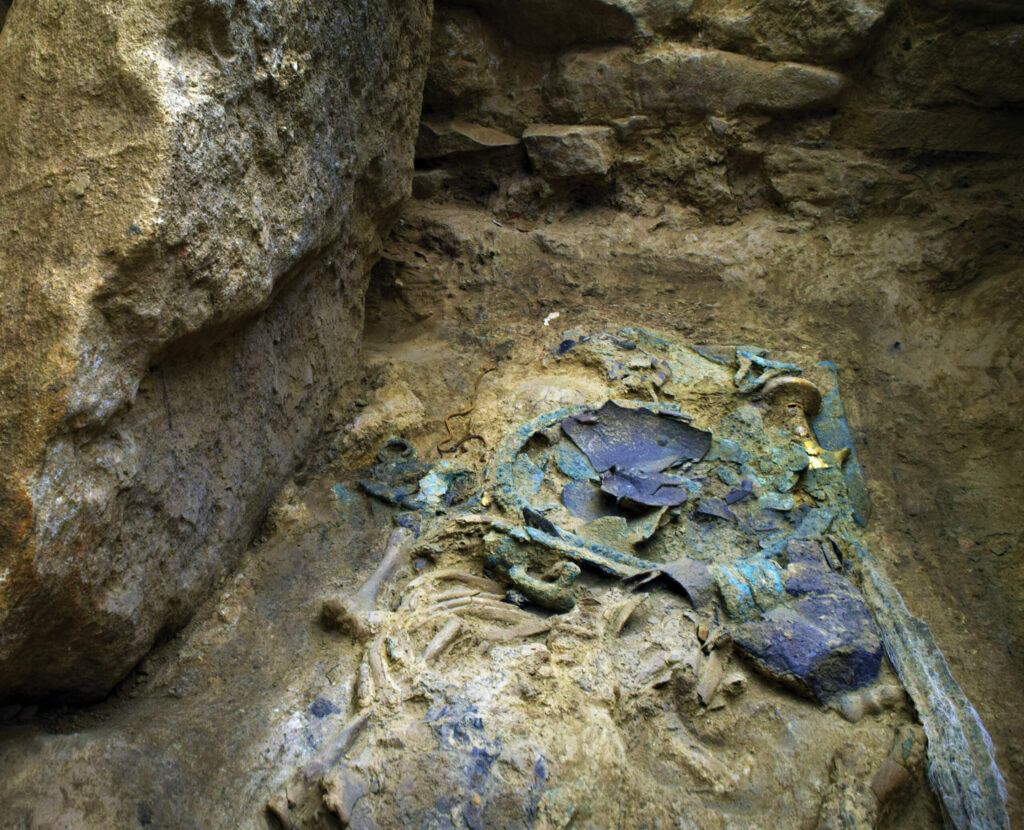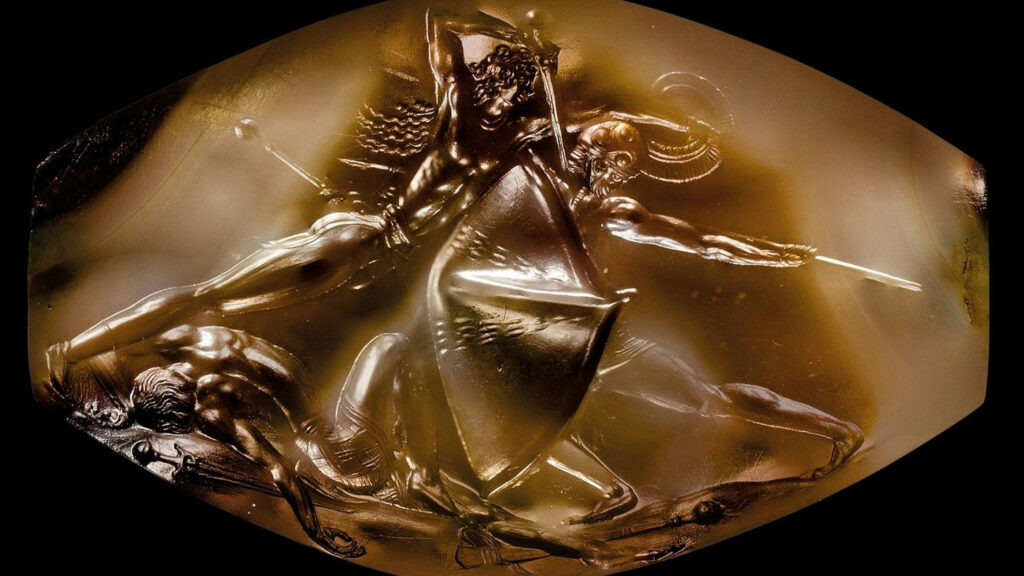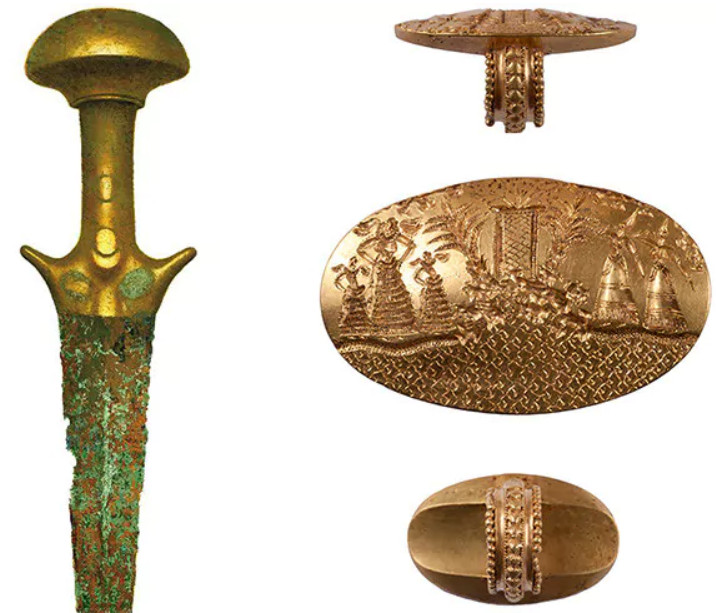In 2015, a remarkable archaeological discovery in Pylos, Greece, captivated the world. Archaeologists uncovered a grave dating back to around 1450 B.C., belonging to a warrior known as the “Griffin Warrior.” Among the array of artifacts found in his tomb, one object stood out as a testament to the cultural exchange that permeated the Aegean Bronze Age – a bronze sword with an ornate gold pommel.
This sword, with its striking similarities to the iconic swords of the Minoan civilization on the island of Crete, has become the centerpiece of an intriguing historical puzzle. Its presence in the Griffin Warrior’s grave, along with the discovery of the Pylos Combat Agate – a detailed seal stone depicting a warrior wielding a sword akin to the Minoan blade – has opened a window into the interconnected world of these ancient civilizations.
In this blog post, we’ll explore the significance of the Griffin Warrior’s sword, delve into the Minoan influence on its design, and unravel the connections between the Mycenaean and Minoan cultures that this remarkable artifact represents.
The Minoan Hallmark: The Horned Hilt
The Minoans were renowned for their exceptional craftsmanship, and their swords were no exception. A distinguishing feature of these weapons was the distinctive “horned” hilt, with projections at the base that formed a guard for the warrior’s hand. This unique design was prevalent in Minoan art and archaeological findings across Crete, a signature of their metalworking prowess.

The presence of a Minoan-style sword in the Griffin Warrior’s grave suggests a strong cultural connection between the Mycenaeans and the Minoans. It raises intriguing questions about the nature of this relationship – was the warrior himself of Minoan origin, or had he acquired the sword through trade, warfare, or admiration for Minoan craftsmanship?
The Pylos Combat Agate: A Warrior Immortalized
Accompanying the Griffin Warrior’s remains was a tiny but incredibly detailed seal stone, known as the Pylos Combat Agate. This intricate carving depicts a fierce combat scene, with a warrior – presumably the Griffin Warrior himself – wielding a sword that bears an uncanny resemblance to the horned-hilt Minoan blade found in the grave.
The Pylos Combat Agate serves as a visual confirmation of the connection between the Mycenaean warrior and the Minoan-style sword. It immortalizes the Griffin Warrior in the act of combat, wielding a weapon that symbolizes the cultural exchange and influence that permeated the Aegean region during the Bronze Age.
Unraveling the Connections
The presence of the Minoan-style sword in the Mycenaean warrior’s grave and its depiction on the Pylos Combat Agate point to a profound cultural connection between these two civilizations. Several possibilities emerge:
- The Griffin Warrior as a Minoan? The warrior himself may have been of Minoan origin, carrying the traditions and weapons of his homeland with him to his final resting place in Pylos.
- Acquisition through Trade or Warfare: The Griffin Warrior may have acquired the sword through trade, warfare, or admiration for Minoan craftsmanship, reflecting the exchange of goods and ideas across the Aegean.
- A Symbol of Status and Prestige: The sword could symbolize the warrior’s status and prestige, as finely crafted weapons were coveted symbols of power in the Bronze Age.

Regardless of the specific circumstances, the Griffin Warrior’s sword stands as a testament to the interconnectedness of the Aegean world during the Bronze Age. It reminds us that even in ancient times, civilizations were not isolated entities but rather part of a intricate web of cultural exchange, where the skills of warriors and craftsmen transcended borders and influenced one another.
The Sword that Bridged Civilizations
The Griffin Warrior’s sword, with its Minoan-inspired design, serves as a physical embodiment of the cultural connections that existed between the Mycenaeans and the Minoans. It represents the exchange of ideas, the admiration for exceptional craftsmanship, and the shared warrior traditions that permeated the Aegean region during this pivotal period in history.

As we continue to unravel the mysteries of the past, the Griffin Warrior’s enigmatic sword stands as a reminder of the enduring human desire for artistry, prestige, and the perpetuation of cultural legacies through remarkable artifacts. This sword, a bridge between civilizations, invites us to delve deeper into the rich tapestry of the Aegean Bronze Age, and to appreciate the remarkable achievements of the ancient world.
Conclusion

The discovery of the Griffin Warrior’s grave in Pylos has captivated scholars and the public alike, with the warrior’s bronze sword at the heart of this enigmatic tale. This remarkable artifact, with its Minoan-inspired design, has become a testament to the cultural exchange and interconnectedness that defined the Aegean Bronze Age.
As we explore the significance of this sword and the insights it provides into the relationship between the Mycenaeans and the Minoans, we are reminded of the enduring power of material culture to reveal the stories of the past. The Griffin Warrior’s sword stands as a bridge between civilizations, a tangible link to a time when the skills of warriors and craftsmen transcended borders and shaped the course of history.

